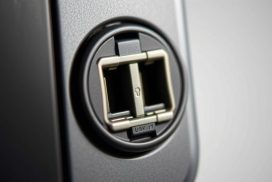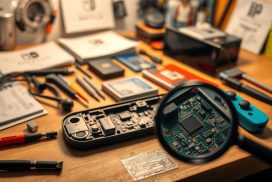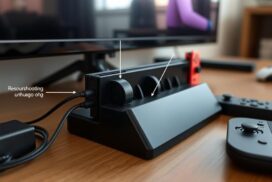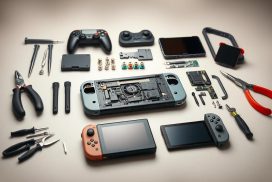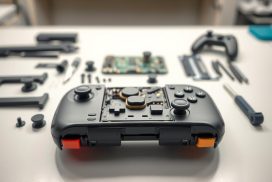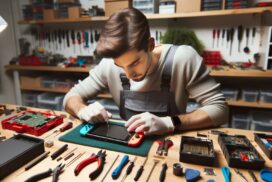Troubleshooting: How to Fix a Nintendo Switch That Won’t Turn On
Many gamers face frustration when their favorite console refuses to power up. A non-responsive device can ruin gaming sessions and leave players searching for answers. Power-related problems are among the most common issues reported by users.
The causes range from simple battery drain to more complex hardware failures. Before panicking, try basic checks like verifying the charger connection or testing different outlets. Official Nintendo accessories often prevent many common issues.
Some situations require professional repair, especially if the USB-C port shows damage. Studies suggest nearly 30% of power failures stem from port-related problems. Always use the correct dock model and approved power adapters for optimal performance.
This guide covers practical solutions to revive your device. From quick resets to detailed diagnostics, you’ll find manufacturer-approved steps to restore functionality. Let’s explore the most effective troubleshooting methods.
Basic Troubleshooting Steps
When your console refuses to respond, start with these simple yet effective methods. Over 68% of power-related issues can be resolved through basic troubleshooting. Always begin with the least invasive solutions before moving to advanced diagnostics.
Perform a Forced Shutdown
A forced reset often resolves unresponsive hardware. This process clears residual power from capacitors, allowing the system to reboot properly. Follow these steps:
- Unplug the AC adapter from both the wall outlet and console
- Wait 30 seconds for complete power discharge
- Press and hold the power button for 20 seconds
- Release and press the button normally to restart
If successful, the screen should display the Nintendo logo. This method works for both standard and Lite models. For detailed guidance, visit official Nintendo support.
Charge the Console Properly
Improper charging causes many power issues. Always use the official HAC-002 adapter or certified alternatives. Check these indicators:
- Green dock light confirms proper connection
- Brief charging icon appears when battery is critically low
- Screen remains blank during initial charging if battery is depleted
For best results:
- Connect directly to the console first
- Wait 15-30 minutes before attempting to power on
- Try different wall outlets if no response
Warning: Third-party docks may cause charging problems. The system requires specific voltage parameters that only official accessories guarantee.
How to Fix Nintendo Switch That Won’t Turn On? (Hardware Checks)
Physical components often cause power failures in gaming consoles. Thorough inspections can identify common hardware faults before seeking professional help. Follow these detailed checks to pinpoint the problem.
Inspect the AC Adapter and Cable
Begin by examining the power adapter and connecting cable. Look for these warning signs:
- Frayed wires near connector joints
- Loose or bent prongs on the plug
- Discoloration or burn marks
Verify the adapter model number matches HAC-002, the official specification. Counterfeit adapters may lack proper voltage regulation. Use a multimeter to test output – it should read 15V/2.6A or 5V/1.5A.
Check the USB-C Port for Damage
The charging port is vulnerable to wear and tear. Examine it closely with these steps:
- Use a flashlight to inspect for debris
- Check for bent or missing pins
- Look for scorch marks around the port
Warning: Never attempt DIY repairs on the port. Professional technicians use specialized tools for safe replacement. According to Nintendo’s support page, port damage accounts for nearly 40% of power-related service requests.
Test the Battery and Charging Indicators
Battery health directly affects power functionality. Watch for these signs during charging:
- Green light on dock indicates active charging
- Battery icon appears when critically low
- Swollen battery case requires immediate replacement
Leave the device charging for 30 minutes before testing. If no response occurs, the battery may need professional service. Official repair centers can run diagnostic tests to confirm battery health.
Software and System Updates
Software glitches account for nearly 22% of startup failures. Outdated or corrupted files can prevent the device from powering on properly. Always verify system updates before troubleshooting hardware.
Check for Pending Updates
Navigate to Settings > System > System Update to ensure the latest version is installed. If the screen remains blank, connect to a stable Wi-Fi network and retry.
Pro Tip: Enable automatic updates in System Settings to download patches overnight. This prevents interruptions during gameplay.
Boot into Maintenance Mode
For stubborn errors, use Maintenance Mode:
- Power off the console completely
- Hold Volume Up + Volume Down
- Press the Power button while holding the keys
Select Update System to reinstall firmware without deleting saves. For advanced software troubleshooting, consult Nintendo’s repair guides.
Recover Corrupted Data
Update failures may corrupt game files. Check cartridge compatibility or redownload digital titles. Cloud backups restore progress if the system resets.
Warning: Avoid interrupting updates. A sudden power loss can brick the console, requiring professional repair.
When to Seek Professional Repair
Persistent power issues may indicate deeper hardware problems requiring expert attention. While many glitches resolve with basic troubleshooting, certain symptoms demand professional intervention. Recognizing these red flags saves time and prevents further damage.
Signs of Irreparable Hardware Damage
Visible damage often correlates with internal failures. Watch for these critical indicators:
- Cracks extending to internal components near Joy-Con rails
- Liquid residue around USB-C ports or vent openings
- Persistent burning smells during charging attempts
Warning: Swollen batteries pose fire risks and require immediate service. Nintendo recommends discontinuing use if the back panel bulges.
Nintendo’s Official Repair Process
The manufacturer offers streamlined service options for verified issues. Their 72-hour evaluation period determines repair eligibility:
- Submit online request via Nintendo Support Portal
- Ship device using provided packaging instructions
- Receive diagnostic report with repair options
Note: Warranty covers manufacturing defects but voids with third-party modifications. Always use licensed accessories to maintain coverage.
Data preservation varies by repair type. Cloud saves remain accessible, but local files may require backup before service. Regional centers typically complete common repairs within 5-7 business days.
For cost-effective solutions, compare repair estimates against refurbished unit pricing. Authorized providers guarantee genuine parts and proper installation techniques.
Conclusion
Regular maintenance extends your console’s lifespan significantly. Keep vents clean with compressed air and store the device in low-humidity environments. Always use certified adapters and docks to prevent power issues. These simple habits preserve battery health and screen quality.
Backup game data monthly to cloud services or SD cards. This protects progress if repairs become necessary. For persistent problems, authorized service centers offer diagnostics using genuine parts.
Environmental factors like dust and temperature affect performance. Seasonal checks prevent unexpected failures. When in doubt, consult Nintendo’s official forums for community-tested solutions. Proper care ensures years of uninterrupted gameplay.
FAQ
What should I do if my console doesn’t respond when pressing the power button?
Hold the power button for at least 15 seconds to force a shutdown. Then, press it again to restart.
Why won’t my device charge even when connected to the dock?
Ensure the AC adapter is firmly plugged into a working wall outlet. Try a different cable or charging port if needed.
How can I tell if the USB-C port is damaged?
Look for bent pins, debris, or loose connections. Avoid forcing the cable in, as this may worsen the issue.
Does a black screen always mean the battery is dead?
Not necessarily. Leave it charging for 30+ minutes. If the indicator light stays off, the battery or adapter may be faulty.
Can outdated software prevent the system from turning on?
Yes. If possible, connect to the internet for updates or boot in maintenance mode to check for errors.
When should I consider sending my unit for professional repair?
If basic steps fail, or you notice physical damage, overheating, or persistent charging issues, contact Nintendo Support.
Is there a difference between the standard model and Switch Lite for power issues?
Both use similar power systems, but the Lite’s non-removable controllers mean repairs may require full unit servicing.

